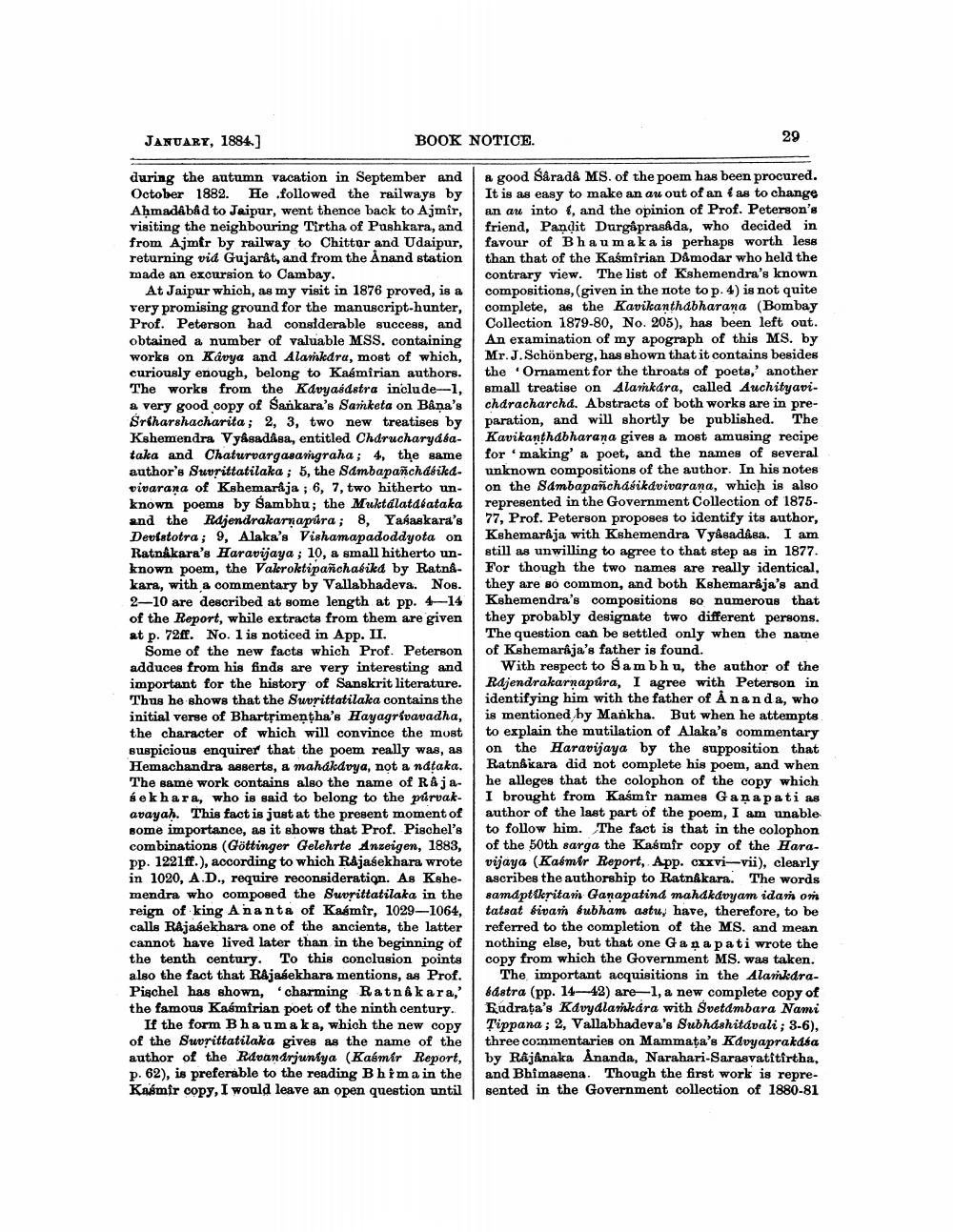________________
BOOK NOTICE.
JANUARY, 1884.]
during the autumn vacation in September and October 1882. He followed the railways by Aḥmadâbâd to Jaipur, went thence back to Ajmir, visiting the neighbouring Tirtha of Pushkara, and from Ajmir by railway to Chittur and Udaipur, returning vid Gujarât, and from the Anand station made an excursion to Cambay.
At Jaipur which, as my visit in 1876 proved, is a very promising ground for the manuscript-hunter, Prof. Peterson had considerable success, and obtained a number of valuable MSS. containing works on Kavya and Alamkára, most of which, curiously enough, belong to Kaémirian authors. The works from the Kavyasdstra include-1, a very good copy of Sankara's Samketa on Bana's Sriharshacharita; 2, 3, two new treatises by Kshemendra Vyasadâsa, entitled Charucharyásataka and Chaturvargasamgraha; 4, the same author's Suvrittatilaka; 5, the Sambapañchábikavivarana of Kshemarâja; 6, 7, two hitherto unknown poems by Sambhu; the Muktálatábataka and the Rajendrakarnapúra; 8, Yasaskara's Devistotra; 9, Alaka's Vishamapadoddyota on Ratnakara's Haravijaya; 10, a small hitherto unknown poem, the Vakroktipañchasikd by Ratnakara, with a commentary by Vallabhadeva. Nos. 2-10 are described at some length at pp. 4-14 of the Report, while extracts from them are given at p. 72ff. No. 1 is noticed in App. II.
Some of the new facts which Prof. Peterson adduces from his finds are very interesting and important for the history of Sanskrit literature. Thus he shows that the Suvrittatilaka contains the initial verse of Bhartrimentha's Hayagrivavadha, the character of which will convince the most suspicious enquirer that the poem really was, as Hemachandra asserts, a mahákávya, not a náṭaka. The same work contains also the name of Rajasekhara, who is said to belong to the purvakavayaḥ. This fact is just at the present moment of some importance, as it shows that Prof. Pischel's combinations (Göttinger Gelehrte Anzeigen, 1883, pp. 1221ff.), according to which Rajasekhara wrote in 1020, A.D., require reconsideration. As Kshemendra who composed the Suvrittatilaka in the reign of king Ananta of Kasmir, 1029-1064, calls Rajasekhara one of the ancients, the latter cannot have lived later than in the beginning of the tenth century. To this conclusion points also the fact that Rajasekhara mentions, as Prof. Pischel has shown, charming Ratnakara,' the famous Kaśmîrian poet of the ninth century.
If the form Bhaumaka, which the new copy of the Suvrittatilaka gives as the name of the author of the Ravandrjuniya (Kasmir Report, p. 62), is preferable to the reading Bhima in the Kasmir copy, I would leave an open question until
29
a good Śâradâ MS. of the poem has been procured. It is as easy to make an au out of an as to change an au into t, and the opinion of Prof. Peterson's friend, Pandit Durgaprasada, who decided in favour of Bhaumaka is perhaps worth less than that of the Kasmirian Dâmodar who held the contrary view. The list of Kshemendra's known compositions, (given in the note to p. 4) is not quite complete, as the Kavikanthábharana (Bombay Collection 1879-80, No. 205), has been left out. An examination of my apograph of this MS. by Mr. J. Schönberg, has shown that it contains besides the Ornament for the throats of poets,' another small treatise on Alamkára, called Auchityavicháracharcha. Abstracts of both works are in preparation, and will shortly be published. The Kavikanthábharana gives a most amusing recipe for making a poet, and the names of several unknown compositions of the author. In his notes on the Sambapañchásikavivarana, which is also represented in the Government Collection of 187577, Prof. Peterson proposes to identify its author, Kshemarâja with Kshemendra Vyasadása. I am still as unwilling to agree to that step as in 1877. For though the two names are really identical, they are so common, and both Kshemarâja's and Kshemendra's compositions so numerous that they probably designate two different persons. The question can be settled only when the name of Kshemarâja's father is found.
With respect to Sambhu, the author of the Rajendrakarnapúra, I agree with Peterson in identifying him with the father of Ananda, who is mentioned by Mankha. But when he attempts. to explain the mutilation of Alaka's commentary on the Haravijaya by the supposition that Ratnakara did not complete his poem, and when he alleges that the colophon of the copy which I brought from Kasmir names Ganapati as author of the last part of the poem, I am unable to follow him. The fact is that in the colophon of the 50th sarga the Kasmir copy of the Haravijaya (Kasmir Report, App. cxxvi-vii), clearly ascribes the authorship to Ratnakara. The words samaptikṛitam Ganapatiná mahákávyam idam om tatsat sivaṁ subham astu, have, therefore, to be referred to the completion of the MS. and mean nothing else, but that one Ganapati wrote the copy from which the Government MS. was taken.
The important acquisitions in the Alamkarasdstra (pp. 14-42) are-1, a new complete copy of Rudrata's Kávyalamkára with Svetámbara Nami Tippana; 2, Vallabhadeva's Subhashitávali; 3-6), three commentaries on Mammata's Kavyaprakása by Rajanaka Ananda, Narahari-Sarasvatitirtha, and Bhimasena. Though the first work is represented in the Government collection of 1880-81




